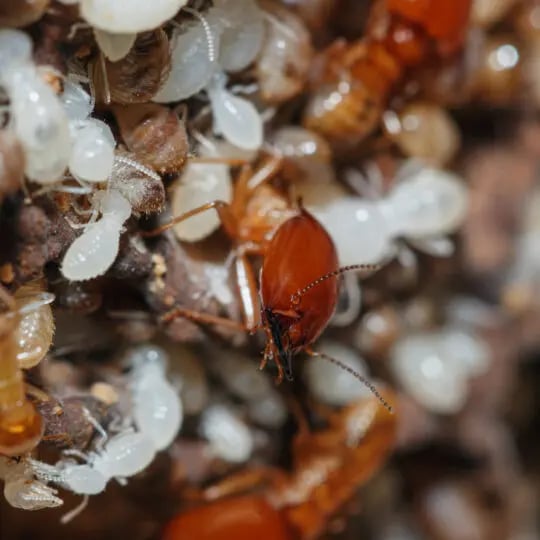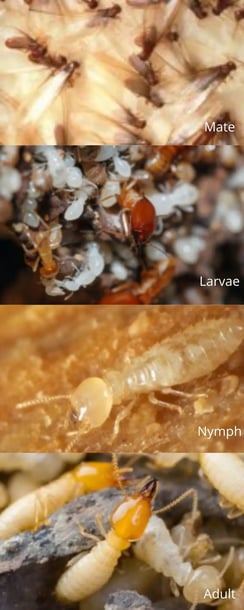How to Identify Termite Larvae
And the Termite Life Cycle

Updated March 2021
Termites are costly pests, potentially causing thousands of dollars of property damage to homeowners and business owners. The sooner you identify a problem, the better for your home and your wallet. How do you know if you have a problem? There are a couple of signs to look out for like wood damage, coffee-ground-like feces (also known as frass), and discarded wings. While spotting termite larvae probably won’t be your first clue, it’s still important to know how to identify them. Read on to learn about termite larvae and the life cycle of this destructive pest.
How to Identify Termite Larvae
Color: White, almost translucent
Size: Approximately 1/10″
Appearance: Larvae aren’t much bigger than the tiny eggs they hatch from. They look very similar to worker termites, just smaller and soft.
Location: Larvae (also known as immatures) are found in termite mounds, which are nests made of sand, wood particles, and other natural components held together by termite worker saliva. Hidden away in the safety of the nest, you often won’t see these tiny members of the colony. The adult termites take care of them by feeding them a steady diet of cellulose until they molt and become nymphs strong enough to move around and out of the mound.
Life Cycle of a Termite

1. Mating: There are specific termites whose job is to reproduce to help the colony grow quickly. The life cycle begins when reproductive termites leave the nest to procreate, and sometimes they’ll then form their own adjacent colony, becoming queens themselves. The queen termite is slightly larger than worker termites, and it is her job to lay the eggs necessary to establish a colony. Peak egg production lasts approximately 10 years, while queen termites can live 25 to 50 years. Depending on the size of the colony, there might be secondary or tertiary reproductives.
2. Egg and Larvae: The fertilized queen lays her eggs. These eggs are very small, white, and oval-shaped. Don’t expect to see any! Most are located below ground or concealed within structures. After incubating for a few weeks, the eggs hatch into larvae.
3. Molting: The larvae shed their exoskeletons, called molting, and then become nymphs. They develop into castes, like workers, soldiers, and other reproducers. They may molt many times to meet the colony’s needs, changing castes.
4. Maturity: At maturity, the termites go off and do their job. For example, the reproductive termites develop wings and functioning eyes, and their bodies become harder and darker to accommodate the elements outside of the nest. They swarm as their parents did, and the termite lifecycle begins again.
If You Found Termite Larvae, Call Green Pest Solutions
Each year, these voracious insects cause over $5 billion worth of structural damage throughout the United States. Don’t hesitate to call the pest professionals at Green Pest Solutions if you’re dealing with a termite problem. We know how expensive termite damage can be if not treated right away, and we also know the best ways to rid your home of them. Give us a call today at 855-312-7157.